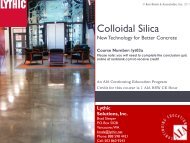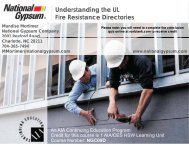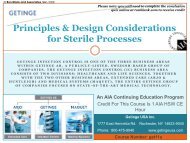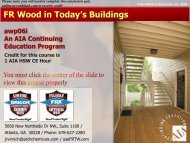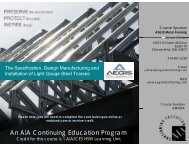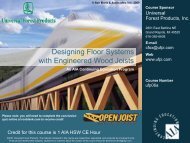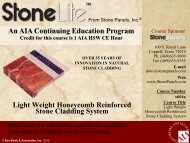improving timber connections through design - Ron Blank ...
improving timber connections through design - Ron Blank ...
improving timber connections through design - Ron Blank ...
Create successful ePaper yourself
Turn your PDF publications into a flip-book with our unique Google optimized e-Paper software.
AN AIA CONTINUING EDUCATION PROGRAMApproved Promotional Statement:<strong>Ron</strong> <strong>Blank</strong> & Associates, Inc. is a registered provider with The American Institute ofArchitects Continuing Education System. Credit earned upon completion of thisprogram will be reported to CES Records for AIA members. Certificates ofCompletion are available for all course participants upon completion of the courseconclusion quiz with +80%.Please view the following slide for more information on Certificates of Completion<strong>through</strong> RBAThis program is registered with the AIA/CES for continuingprofessional education. As such, it does not include content thatmay be deemed or construed to be an approval or endorsementby the AIA or <strong>Ron</strong> <strong>Blank</strong> & Associates, Inc. of any material ofconstruction or any method or manner of handling, using,distributing, or dealing in any material or product.
AN AIA CONTINUING EDUCATION PROGRAMCourse Format: This is a structured, web-based, self study course with a final exam.Course Credit: 1 AIA Health Safety & Welfare (HSW) CE HourCompletion Certificate: A confirmation is sent to you by email and you can print oneupon successful completion of a course or from your <strong>Ron</strong><strong>Blank</strong>.com transcript. Ifyou have any difficulties printing or receiving your Certificate please send requeststo certificate@ronblank.comDesign professionals, please remember to print your certificate of completion aftersuccessfully completing a course conclusion quiz. Email confirmations will be sentto the email address you have provided in your <strong>Ron</strong><strong>Blank</strong>.com account.Please note: you will need to complete the conclusion quiz online atronblank.com to receive credit
IMPROVING TIMBER CONNECTIONS WITH STEEL EMBEDDEDCONNECTORSDescriptionObjectives
DESCRIPTIONTraditionally, <strong>connections</strong> in heavy <strong>timber</strong> structures(including glulam and log) were concealed. Approachesto achieving concealed <strong>connections</strong> include all-woodjoinery, typical of <strong>timber</strong> frame construction. Whennecessary, because of engineering constraints, knifeplates secured with bolts or drift pins are used. Theseusually have the nuts and bolts exposed.Steel embedded <strong>timber</strong> connectors provide analternative, low-cost connection system that preservesthe appearance of traditional joinery.
OBJECTIVESBy the end of thispresentation, youwill be able to: Compare traditional mortise and tenon (MT)joinery with embedded <strong>timber</strong> connectors Identify parts of a common <strong>timber</strong> frame Design for tension, compression, and shearutilizing steel embedded connectors Explain the installation of an embedded<strong>timber</strong> connector Specify different styles of embeddedconnectors for wood to wood, wood toconcrete, and wood to steel <strong>connections</strong>
HISTORYTimber Joinery Methods
HISTORY-Timber Joinery MethodsHistorically, when building with <strong>timber</strong>, the joinery method was Mortise (a pocketcut into a piece of wood) and Tenon (a blade on the end of a member). Thesejoints were secured using pegs, dowels and leather or cord lashings. Traditionally,a mortise and tenon joint was cut by hand. This method was passed down fromgeneration to generation <strong>through</strong> the guild system.With the advent of the Industrial Revolution, commercial saw mills developed thecapacity to mass produce small pieces of lumber that could be nailed together.Then Balloon and Platform framing became the common method of building, andhouses could be built quickly with an inexperienced work force. This virtuallyeliminated <strong>timber</strong> framing in North America.A <strong>timber</strong> frame revival began in the early 1970’s. There was little technical data onmortise and tenon joinery resulting in many trial and error methods. cont’d
HISTORY-Timber Joinery MethodsWhen engineering constraints dictated, external steel plates and dowel typeconnectors such as nails, spikes, bolts and screws were used. Various attemptswere made to hide these fasteners.The need for a mechanical connector was born.Embedded <strong>timber</strong> connectors provide a traditional appearance and give<strong>design</strong>ers and engineers a predictable failure mode that can be quantified.With the addition of embedded connectors, the scope of <strong>design</strong> has reachedunlimited horizons.In 2007, there were approximately 15,000 <strong>timber</strong> frame and log home buildings inNorth America plus an unknown number of hybrid <strong>timber</strong> frames.
The demand for these magnificentlong-lasting structures has returnedwith a vengeance.
HISTORY-Timber ConnectorsOriginally <strong>design</strong>ed to simply jointwo <strong>timber</strong>s together (right)The availability of mechanicalconnectors has expanded to includemany different types which give theflexibility to replace any mortise andtenon joint, as well as achieveadditional joints that were notpossible before
TIMBER CONNECTORSDescribe the evolution of embedded <strong>timber</strong> connectorsCompare with traditional mortise and tenon (MT) joinery
THE NEED FOR STEEL EMBEDDED JOINERYAs interest in <strong>timber</strong> framing revived, traditional methods of joinery were studied.Large structures such as barns and cathedrals had been built using this system.The original buildings were very big, so hiding hardware behind or on top of thejoint was common. But then there arose a need for building on a smaller scale –homes, cottages, etc.The joints in a <strong>timber</strong> frame are the weakest parts of the building. Each piece ofwood has different characteristics. Therefore, defining the <strong>design</strong> value of amortise and tenon joint is more difficult than defining the value of an embeddedsteel connector which remains constant.Originally, when extra strength was required, the builders who had studied theold methods used what they had seen in the past – external metal plates,straps, nuts and bolts.
THE NEED FOR STEEL EMBEDDED JOINERYEmbedded connectors came from the need to create a better joinery system thathad well defined <strong>design</strong> values. Steel, in one form or another, has been used toenhance and help join wooden structures since the beginning of <strong>timber</strong> joinery,initially in the form of steel straps and nails usually hidden on top of the joineryout of sight. Steel embedded joinery was <strong>design</strong>ed to be set into the wood andtransfer loads between members by a combination of connectors in tension, and<strong>timber</strong> members in compression. Steel has tremendous tensile strength,especially compared to the traditional wood dowel connectors. The original ideaof steel embedded joinery was born out of the need to provide definedengineered values, simplicity of installation and a traditional appearance.
THE NEED FOR STEEL EMBEDDED JOINERYEmbedded connectors provide defined engineering values:“As engineers, we value connection systems that produce predictable failuremodes, and that fail in the steel components where homogeneity and lowermaterial variability lead to more accurate strength calculations.When steel failure governs, ductilitycan be included in the connection<strong>design</strong> - a preferable quality forstructures in seismic regions”(Moses and Malczyk)
MORTISE AND TENON JOINTSHoused mortise and tenonA traditional <strong>through</strong>, wedged, mortise and tenon joint
MORTISE AND TENON JOINTSOpen mortise and tenon (a.k.a. Fork and Tongue Joint)Mortise and tenon with diminished haunch
MORTISE AND TENON JOINTS Traditional spline joint Embedded connector spline joint
Embedded Spline Joint And TraditionalSpline Joint Intersecting In The Same Location
COMPARISON-Mortise and TenonWood governs failureExperienced <strong>timber</strong> framerrequired to constructTime consuming unless youhave expensive equipmentLonger assembly timeExtreme accuracy requiredwhen drilling peg holes fordraw boring
COMPARISON-Embedded Timber ConnectorPredictable failure modesLess wood removed to produce joint4-way joinery connection possible nowCan use smaller members in some casesMaintains traditional appearanceCan be tightened during and after assemblyExpansion pins put joint in compressionReduces shrinking effectPipe itself has shear valueFast, reliable and easy to installVersatile
Timber Connectors vs.Mortise and Tenon ComparisonGeneral Information: 8 in 12 roof pitch 24' wide, collar tie raised 2‘6“ Timbers are 8" wide #1Douglas Fir Full sawn, at 12% M.C. Loads are: 10psf DL, 40psf SL(projected) Trusses are spaced at 12' o.c. DL + SL loading controls Timber <strong>design</strong> per NDS(National Design Standard)Example: A simple raised collar roof systemAnalysis: Minimum Timber sizes: Rafter = 8 x 14 (beam and stringer) Collar Tie = 8 x 8 (post and <strong>timber</strong>) max tension in collar tie T collar := 8630 lbf max moment in rafter (at collar tie) M rafter := 302350 lbf·in
Timber Connectors vs.Mortise and Tenon Comparison Con’tTimber Connectors Required:2 pairs of 6.75” double slotted embedded steel connector + Threaded Rod per jointRafter size: 8” x 14”Collar Tie size: 8” x 8”To accomplish the same results using mortise and tenon, you must increase the sizesof the rafters and the collar tie. (Detailed calculations available upon request)Rafter size: 8” x 16”Collar Tie size: 8” x 16”Wood required with steel connectors: 2x 8”x14”x16’ + 1x 8”x 8”x18’ = 394.662 BFTWood required for mortise and tenon: 2x 8”x16”x16’ + 1x 8”x16”x18’ = 533.333 BFTCost of #1 Douglas Fir full sawn, at 12% M.C. $2.25 BFTCost savings on wood per truss $312.00ALL TRUSSES ARE ONLY AS STRONG AS THEIR JOINTS
Allowable Stress Tension Design Value Comparisonof Embedded Steel / Mortise & Tenon ConnectionsTimber (1)SpecificGravityEmbedded SteelConnection(2), (5)Mortise and TenonConnection(3), (4), (5)Capacity(lb)l e(in) l s(in)Capacity(lb)l e(in) l s(in)Eastern WhitePine0.36 1,930 5.25 3.0 725 3.36 1.92Port Orford Cedar 0.39 2,440 5.25 3.0 770 3.36 1.92Douglas Fir 0.50 2,210 5.25 3.0 935 3.15 1.80White Oak 0.73 5,320 3.75 3.0 1180 2.20 1.76Con’t
Tension DesignCont…1) Timbers are 6-inch square crosssection with T connection. Stem ofT is loaded in tension. (seefigures on previous slide)2) Connection with one 9.5” steelembedded connector (imageright)3) Connection with 1.5-inch thicktenon and one 1-inch diameterwhite oak peg (image left)lelslsle4) Design value and detailingdimensions determined fromTFEC 1-07, Standard for Designof Timber Frame Structures5) Detailing based on NDS & CSAO86-01 provisionsNote: the tenon must be thissize to achieve the stated values.Con’t
Net Section EffectsSection 3.1.2 of the NDS states:“The net section area shall be used in calculating the load carrying capacity of amember.”On the previous slide we find that the mortise & tenon would require 45 in³ ofwood to be removed from the post to accommodate the tenon (approx 1/3 rd ofa 6”x6” post fully removed). A steel embedded connector would only require 11¼ in³ to be removed, establishing a much stronger post.When a mortise and tenon connection is used in some building jurisdictions,California for example, they only allow the post value of its reduced size forloading calculations, reducing the once 6”x6” post to that of only a 4”x6”.In this case, the post utilizing the mortise & tenon would most likely need to beincreased in size from 6”x 6” to 8”x 8”.In the same situation, the steel embedded connector would not only be at leastthree times as strong but would be paid for in the cost savings on wood alone.
STEEL TIMBER CONNECTORSThis is a simple, concealed andadjustable fastening system. Itconsists of a hollow steel connectiontube with elongated slots whereexpanding cross pins are inserted.13.5” tube with expansion pins
CONNECTOR DESCRIPTIONA: Connecting TubeB: Expansion pinC: Pin SlotD: Tightening boltE: Expansion WedgesF: Positioning Shoulder
DESIGNING WITH TIMBER FRAMESIdentify parts of a common <strong>timber</strong> frame (use illustration)Understand and learn how to <strong>design</strong> for tension, compression, and shear
COMMON TIMBER FRAMEParts of a common <strong>timber</strong>frame using mortise andtenon joinery.Embedded steel connectorscan be used in all of the jointsillustrated, which wouldprovide additional strengthand stiffness to the building.
CONNECTIONSCOMPRESSIONTENSIONSHEAR
TENSION DESIGN: Embedded ConnectorLoading Parallel to grain(in lbs)Eastern WhitepinePort OrfordcedarLimit StatesDesignWorking StressDesign4,700 3,2705,080 3,530White oak 7,640 5,320Values for other species may be determined byinterpolation, using published specific gravities.
TENSION DESIGN: Embedded ConnectorLoading Perpendicular to grain(in lbs)Eastern WhitepinePort OrfordcedarLimit StatesDesignWorking StressDesign2,780 1,9303,500 2,440White oak 7,640 5,320Values for other species may be determined byinterpolation, using published specific gravities.
SHEAR DESIGN1 1/8” Tube carries all shear Design using published yield model equations fordowel connectors No interaction between shear capacity andtensile capacityEnhance with Split rings Shear plates Housed <strong>connections</strong>
CONNECTION FORCES – Lateral LoadsTENSION,COMPRESSION& SHEARTENSION,COMPRESSION& SHEARTENSIONCOMPRESSION
CONNECTION FORCES – Gravity LoadsTENSION, COMPRESSION & SHEARCOMPRESSION
INSTALLATIONInstallation methodsDrilling jig and other tools
INSTALLATIONDrilling Jigs:Set jig - drill pipehole and pin holein one operationEasily adjustablefor various sizesComes with brassbushings for 1 1/8"drill bitsOne for Log BuildingOne for Timber Frames
INSTALLATIONPositioning Tool:Made from solid machine steelHelps to position slots exactly forinsertion of pinsBrings joints into position and holdsthem thereDesigned to fit in end of pipe forinsertionPositioning tools
INSTALLATIONInsertion tools:Made from solid machine steelDesigned to fit over machine boltheadApplies force to end of castings sopins can be inserted withoutexpandingInsertion tools
INSTALLATION: AdvantagesEnables four-way and three-way<strong>connections</strong>Can be used in any type of joint:wood to wood, wood to concrete,and wood to steelStrengthens every jointCan be easily tightened with anAllen key and completelyconcealed by a wood plug
INSTALLATIONBeam toWooden Post:9.5” STEELEMBEDDED CONNECTOR
INSTALLATIONPost to Concrete:4-3/4” STEELEMBEDDED CONNECTOR
INSTALLATIONThree-wayconnection:17-3/4” STEELEMBEDDEDCONNECTORThe number of connectors required isdefined by the tension and shear loads.
INSTALLATIONFour-wayconnection:17-3/4” STEELEMBEDDEDCONNECTORTwo connectors for each joint for illustration only.The number of connectors required is defined bythe tension and shear loads.
INSTALLATIONTension Rod toConnector:4-3/4” STEELEMBEDDED CONNECTOR
INSTALLATIONBeam to Steel:4-3/4” STEELEMBEDDEDCONNECTOR
STYLESDifferent styles of embedded connectorsApplications
STYLESThere are currently 10 different types of<strong>timber</strong> connectors: 9.5” straight slot and 90° Slot Overall length 9.5” Pin holes center to center 7 3/4”Both identical except orientation ofslots to provide versatile pin access Applications:General joining applicationUsed for all official testing9.5” STRAIGHT SLOTS 9.5” 90° SLOTS
STYLES13.5” pipe connector, straight slotsStraight slots Pin holes center to center 11 3/4” Applications:Designed to replace a 9.5” connector inlarger <strong>timber</strong>sProvides a 7 x pin diameter from edge ofthe joint (NDS)
STYLES15.5” straight slot and 90° Slot Overall length 15.5” Pin holes center to center 13 ¾”Applications:Designed to join 2 beams to a post6X6” <strong>timber</strong> butt joints at post8X8” <strong>timber</strong> 1” housed joints at postReplaces spline joint (saves labor andadds strength)Joins 4 beams to a post at 1 point15.5” STRAIGHT SLOTS 15.5” 90° SLOTS
STYLES17.5” straight slot and 90° Slot Overall length 17.5” Pin holes center to center 15 ¾”Applications:Joins 2 beams to a post8X8” <strong>timber</strong> butt joints at post10X10” <strong>timber</strong> 1” housed joints at postReplaces spline jointJoins large sill beams end to endJoins 4 beams to a post at 1 point17.5” STRAIGHT SLOTS 17.5” 90° SLOTS
STYLES4-3/4” steel embedded connector Overall length 4 3/4”One slot with 7/8” internal thread at other endPin hole centers 3 7/8” plus exposed threadedrod. Applications (new uses discovered everyday):Two 4-3/4” connectors + threaded rod cancustomize any length of <strong>timber</strong> connectorrequiredJoins wood to steel, wood to concrete and woodto wood
STYLES6.75” Half ConnectorOverall length 6 3/4”with two slots parallelPin hole centers 2 7/8” 5 7/8” + exposedthreaded rodTwo slots at one end parallel, internal threadat other endTwice as strong as 4-3/4” in tensionCombine any two of the following half connectorswith threaded rod to customize any connectorimaginable. 4.75”, 6.75”, 6.75” 2 slots parallel,6.75” 2 slots at right anglesJoins wood to steel, wood to concrete, woodto wood
STYLES 6.75” Overall length 6 3/4” with 2 slots at 90°Pin hole centers 3 7/8” 5 7/8” + exposedthreaded rodApplications (new uses discovered everyday):Used to customize any type of <strong>timber</strong> connectorrequired at super strengthJoins wood to steel and wood to concrete woodto wood
APPLICATIONSGeneral Applications:Beam to postRafter to ridgePlate lap at postKnee brace to postCollar tie to rafterThru tension rodTruss heelTruss tension chordTwo-way beam to postFour-way beam to postPost hold downRafter to plate
APPLICATIONSTargeted consumers:Timber FramersPost and BeamLog BuildersSmall ProducersDeck & Fence CompaniesLandscapersCustom BuildersGeneral Contractors
TRUSS STYLESThe <strong>design</strong> of a truss is limited by the strength of the joints
SIMPLE TRUSSSIMPLE TRUSS
KING POST WITH STRUTSKING POST WITH STRUTSThe complex joinery in a truss isthe ideal venue for mechanical fasteners
HAMMERBEAMHAMMERBEAMEmbedded mechanical fasteners with theiradded strength will widen the <strong>design</strong> horizon for trusses
SUMMARYNow you should be able to: Compare traditional mortise andtenon (MT) joinery withembedded <strong>timber</strong> connectorsTalk to the <strong>timber</strong> fabricatorVisualize the installation of anembedded <strong>timber</strong> connectorSpecify different styles ofembedded connectors for woodto wood, wood to concrete, andwood to steel <strong>connections</strong>
© <strong>Ron</strong> <strong>Blank</strong> & Associates, Inc. 2009AN AIA CONTINUING EDUCATION PROGRAMCREDIT FOR THIS COURSE IS 1 AIA HSW CE HourIMPROVING TIMBERCONNECTIONS THROUGH DESIGNCOURSE NUMBER: tlx06aCOURSE SPONSOR:Please note: you will need to complete the conclusion quizonline at ronblank.com to receive creditNeil Maclean / <strong>timber</strong>linx@rogers.com / 1-877-900-3111 / www.Timberlinx.com



